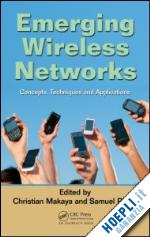Christian Makaya is a senior research scientist in Advanced Technology Solutions, at Telcordia Technologies. He received a Ph.D. degree in computer engineering from the Ecole Polytechnique de Montreal, University of Montreal, Canada in 2007. Prior to joining Telcordia, he was a research fellow and a lecturer within the Department of Computer Engineering of the Ecole Polytechnique de Montreal. He also held a position as principal architect and senior scientist for a start-up consulting firm in Montreal, where he led research and development (R&D) activities in the area of advanced wireless networking technologies and software development. Dr. Makaya has served as a reviewer for numerous international journals, and as a program committee member of several workshops and conferences. The focus of his research interests is on wireless networking and mobile computing, which includes, but not limited to: radio resource management, interworking architectures design, mobility management, performance evaluation, network planning, machine-to-machine communications, IP multimedia subsystem, cloud computing, self-organizing networks, and open source mobile platforms implementation. Dr Makaya has authored numerous technical papers (in journals, conferences and workshops) and book chapters. Samuel Pierre received hisB.Eng. degree in civil engineering in 1981 from Ecole Polytechnique de Montreal, Quebec, Canada,B.Sc. and M.Sc. degrees in mathematics and computer science in 1984 and 1985, respectively, from the UQAM, Montreal, aM.Sc. degree in economics in 1987 from the University of Montreal, anda Ph.D. degree in electrical engineering in 1991 from the Ecole Polytechnique de Montreal. He is currently a Professor of Computer Engineering at Ecole Polytechnique de Montreal, University of Montreal, where he is Director of the Mobile Computing and Networking Research Laboratory (LARIM), Chairholder of the NSERC/Ericsson Chair in Next Generations and Mobile Networking Systems. His research interests include wireline and wireless networks, mobile computing, artificial intelligence, and tele-learning. From 1987 to 1998, he was a Professor at the University of Quebec at Trois-Rivieres prior to joining the TeleUniversite of Quebec, an Adjunct Professor at Universite Laval, Ste-Foy, Quebec, an Invited Professor at the Swiss Federal Institute of Technology, Lausanne, Switzerland, and the University Paris 7, France. Dr. Pierre has received several distinctions such as the Prix Poly 1873 for excellence in teaching (2001 and 2005), Fellow of the Engineering Institute of Canada (EIC) in 2003. He is Fellow of Canadian Academy of Engineering (2008). Dr. Pierre serves on editorial board of several international journals as well as general chair or technical program committee member of various conferences.











